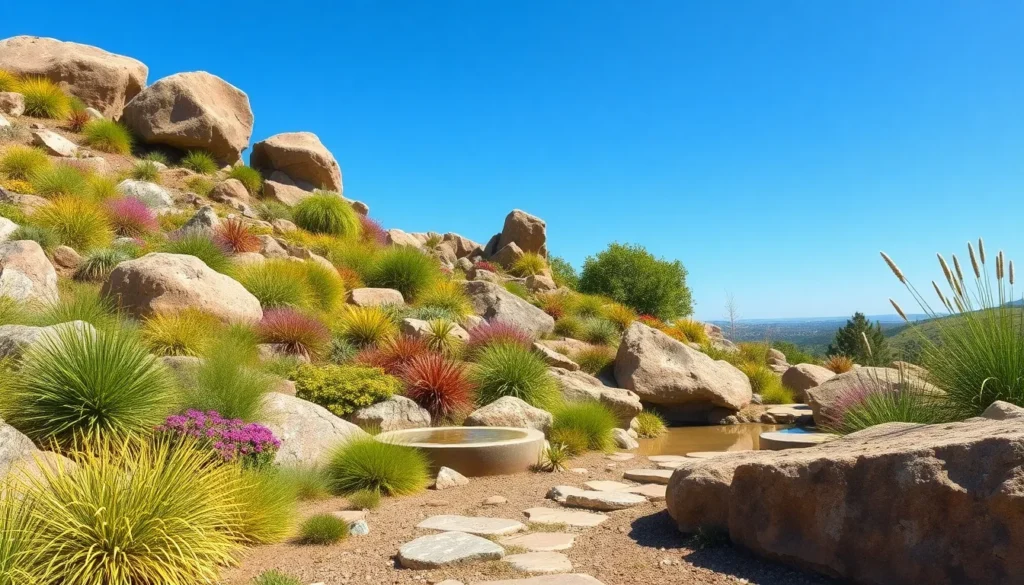Rock gardens transform ordinary landscapes into stunning focal points that require minimal maintenance while delivering maximum visual impact. Whether you’re dealing with challenging terrain like slopes and poor soil or simply want to create an eye-catching feature that thrives in any weather, rock gardening offers endless creative possibilities.
We’ve discovered that the best rock gardens combine natural stone formations with carefully selected plants that complement rather than compete with each other. From alpine succulents that cascade between boulders to ornamental grasses that sway gracefully against rugged backdrops, the right plant-and-stone partnerships create year-round interest with surprisingly little effort.
The beauty of rock gardening lies in its versatility – you can design everything from intimate corner displays to grand hillside installations. We’ll share proven design strategies that work for any space and budget, helping you create a low-maintenance garden that becomes more beautiful with each passing season.
Choose the Perfect Location for Your Rock Garden
The foundation of any successful rock garden lies in selecting the right spot on your property.
Consider Sunlight and Drainage Requirements
Full sun exposure creates the ideal conditions for most rock garden plants, particularly drought tolerant varieties like sedums and alpine perennials. We recommend choosing a location that receives at least 6 to 8 hours of direct sunlight daily for optimal plant growth and flowering.
Proper drainage ranks as the most critical factor for rock garden success since waterlogged soil kills more rock garden plants than drought conditions. Natural slopes provide excellent drainage, while flat areas often require amendments with coarse sand, gravel, or raised bed construction.
South facing locations offer the best combination of maximum sunlight and natural water runoff patterns. These spots typically dry out faster after rain events, mimicking the natural alpine conditions that rock garden plants prefer.
Evaluate Slope and Natural Terrain Features
Gentle slopes between 10 to 30 degrees provide the perfect foundation for rock garden construction without requiring extensive terracing or retaining walls. Steeper inclines create erosion problems, while completely flat areas lack the visual interest that makes rock gardens compelling.
Existing rock outcroppings offer natural anchors for your design and reduce the amount of stone you’ll need to purchase. We suggest incorporating these features as focal points rather than working against the natural industry.
Natural drainage patterns should guide your plant placement decisions since water naturally flows to lower areas during heavy rainfall. Position moisture loving plants like astilbe and coral bells in these collection zones while reserving higher ground for drought tolerant specimens.
Plan for Easy Access and Maintenance
Clear pathways measuring at least 18 inches wide allow comfortable access for routine maintenance tasks like weeding, pruning, and plant division. Stone stepping paths or gravel walkways integrate seamlessly with rock garden aesthetics while providing stable footing.
Proximity to water sources reduces the effort required during establishment periods when new plantings need regular irrigation. We recommend staying within 100 feet of outdoor spigots or considering drip irrigation systems for distant locations.
Tool storage accessibility becomes important for ongoing care since rock gardens require specialized equipment like narrow trowels, long handled weeders, and plant transport containers. Choose locations that don’t require carrying heavy materials up steep grades or long distances from storage areas.
Design Your Rock Garden Layout and Structure

We’ll guide you through creating a cohesive rock garden design that maximizes visual impact while maintaining natural appeal. Strategic planning transforms scattered stones into an organized industry feature that enhances your outdoor space.
Create Natural-Looking Rock Formations
Stacked stones create powerful focal points that symbolize stability and creativity throughout your garden space. We recommend incorporating rows of these formations inspired by Japanese zen gardens to establish visual anchors that draw the eye naturally across different areas.
Large boulders serve as commanding centerpieces that define distinct zones within your rock garden layout. Position these substantial stones first to establish the foundation of your design, then build smaller elements around them for balanced composition.
Sloped gardens use natural inclines to create layered rock formations that appear organically placed over time. We suggest working with existing grade changes to build terraced levels that showcase both stones and plants in harmonious arrangements.
Creeping groundcovers soften the harsh edges of rock formations while maintaining the natural aesthetic you’re seeking. Plant varieties like creeping thyme or moss between stone gaps to create seamless transitions that blur the lines between hardscape and living elements.
Plan Pathways and Viewing Areas
Stepping stones create inviting pathways that encourage exploration while protecting surrounding plantings from foot traffic. We recommend spacing these stones 18 to 24 inches apart to accommodate comfortable walking while maintaining visual flow through your garden design.
Seating areas provide essential rest stops where visitors can appreciate your rock garden’s beauty from strategic vantage points. Natural stone benches or flat boulder surfaces offer comfortable viewing positions that blend seamlessly with the overall industry theme.
Log borders define garden boundaries while adding rustic charm that complements stone elements perfectly. These wooden features create clear transitions between your rock garden and surrounding lawn or planted areas without appearing overly formal.
Incorporate Different Elevation Levels
Tiered designs add dramatic depth and dimension through strategic use of retaining walls or natural slope modifications. We suggest creating three distinct levels to establish visual hierarchy while providing diverse growing conditions for different plant varieties.
Vertical elements introduce height variation through carefully placed perennials, ornamental grasses, and small shrubs between rock formations. These living components break up horizontal stone lines while adding seasonal color and texture changes throughout the year.
Water features like small waterfalls or bubbling springs enhance natural elevation changes while creating soothing sounds that complete the sensory experience. Position these elements at higher elevations to take advantage of gravity flow while highlighting your garden’s topographical interest.
Select the Right Types of Rocks and Stones

Selecting the right rocks and stones forms the foundation of your rock garden’s success. We’ll explore how choosing appropriate materials can create a stunning industry that feels both natural and intentional.
Use Local Stone for Authentic Appeal
Local stones offer unmatched authenticity that transforms your rock garden into a seamless extension of the surrounding industry. We recommend visiting nearby quarries or stone yards to discover materials that naturally occur in your region. These indigenous stones create visual harmony because they’re already part of your area’s geological story.
Native rocks also provide practical advantages beyond their aesthetic appeal. They’re typically more affordable than imported stones since transportation costs are minimal. Weather resistance becomes a natural benefit as these stones have already adapted to your local climate conditions over thousands of years.
Mix Different Textures and Colors
Different textures and colors create visual depth that keeps your rock garden interesting from every angle. We suggest combining smooth river stones with rough granite boulders to establish textural contrast. Weathered limestone adds warm cream tones while darker slate provides dramatic shadows.
Color variation should follow nature’s subtle palette rather than bold contrasts. Earth tones like rust, gray, beige, and muted browns work harmoniously together. Pebbles in various sizes can bridge the gap between larger statement stones while adding subtle color gradients throughout your design.
Surface textures tell different stories in your garden industry. Smooth stones suggest water’s gentle influence while jagged edges hint at dramatic geological events. This natural storytelling creates visual interest that draws visitors deeper into your garden space.
Consider Size and Weight Distribution
Large boulders serve as anchor points that define your garden’s primary focal areas. We position these substantial stones first since they’re difficult to move once plants are established. Smaller rocks fill transitional spaces and create natural pathways between major features.
Weight distribution prevents erosion while maintaining long term stability throughout your rock garden. Heavier stones belong in lower positions where they can support lighter materials above. This layering technique mimics natural rock formations where gravity has sorted materials over time.
Balance becomes crucial when mixing stone sizes within each garden section. We follow the rule of thirds by using 60% medium sized rocks, 30% large boulders, and 10% small accent stones. This proportion creates visual harmony while ensuring structural integrity across different weather conditions.
Pick Drought-Tolerant Plants for Low Maintenance
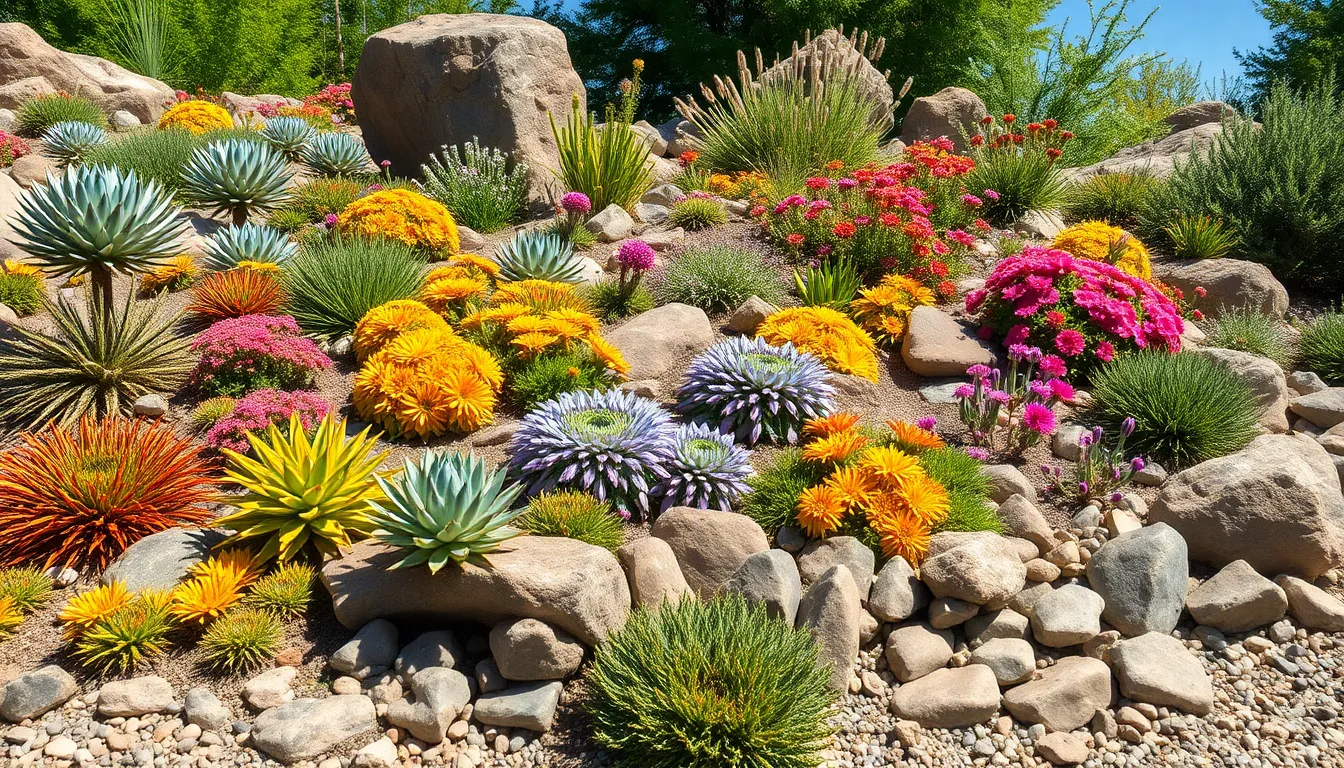
Drought-tolerant plants form the backbone of successful rock gardens, requiring minimal water while thriving in rocky conditions. We’ll focus on selecting varieties that complement your stone foundation while reducing maintenance demands.
Choose Alpine and Succulent Varieties
Alpine plants naturally thrive in rocky environments with excellent drainage and minimal soil. Sedum varieties offer colorful foliage that changes with seasons, creating visual interest throughout the year. Yucca plants provide dramatic architectural elements with their sword-like leaves and tall flower spikes. Agave species contribute bold structural forms while requiring virtually no maintenance once established.
Succulent plants store water in their leaves, making them perfect companions for rock gardens. Hens and chicks spread naturally between rocks, creating living carpets that soften hard edges. Stonecrop varieties produce clusters of tiny flowers that attract beneficial insects during blooming periods. Ice plants cascade beautifully over rock walls, providing colorful ground cover that requires minimal care.
Mountain plants adapt well to harsh conditions similar to those found in rock gardens. Alpine asters produce delicate purple flowers that complement gray stone surfaces. Creeping phlox forms dense mats of colorful blooms that spill between rocks naturally. Candytuft creates white flower clusters that brighten shadowy areas beneath larger boulders.
Select Plants with Different Bloom Times
Spring blooming plants kick off the growing season with early color displays. Crocuses push through late winter snow to provide the first signs of garden life. Rock cress produces masses of white or pink flowers that cascade over stone edges. Pasque flowers emerge with fuzzy buds that open into cup-shaped purple blooms.
Summer flowering varieties maintain garden interest during peak growing season. Blanket flowers bloom continuously from early summer through fall with bright yellow and red petals. Black-eyed Susans provide cheerful yellow flowers that contrast beautifully with dark stone surfaces. Catmint produces spikes of blue-purple flowers that attract butterflies throughout summer months.
Fall blooming species extend the garden’s appeal into cooler weather. Autumn joy sedum develops pink flower heads that deepen to rust colors as temperatures drop. Asters explode with purple, pink, or white flowers just as other plants begin dormancy. Ornamental grasses add movement and texture while producing feathery seed heads for winter interest.
Include Evergreen Options for Year-Round Interest
Evergreen plants maintain garden structure and color throughout winter months. Juniper varieties provide year-round green foliage in spreading or upright forms that complement rock placement. Dwarf conifers offer diverse shapes and needle colors that create focal points among stone arrangements. Pine varieties contribute different textures and growth habits that enhance the natural mountain aesthetic.
Evergreen groundcovers prevent soil erosion while maintaining visual appeal. Creeping thyme forms dense mats that release fragrance when stepped on or brushed against. Wintergreen produces glossy leaves and bright red berries that add color to winter landscapes. Kinnikinnick spreads naturally between rocks while producing pink flowers and red berries.
Year-round foliage plants ensure the garden never appears empty or lifeless. Coral bells offer colorful leaves in shades of purple, silver, or green that persist through mild winters. Heuchera varieties provide different leaf textures and colors that create contrast against stone surfaces. Bergenia produces large, glossy leaves that turn bronze or red in cold weather while maintaining garden presence.
Add Water Features to Enhance Your Rock Garden
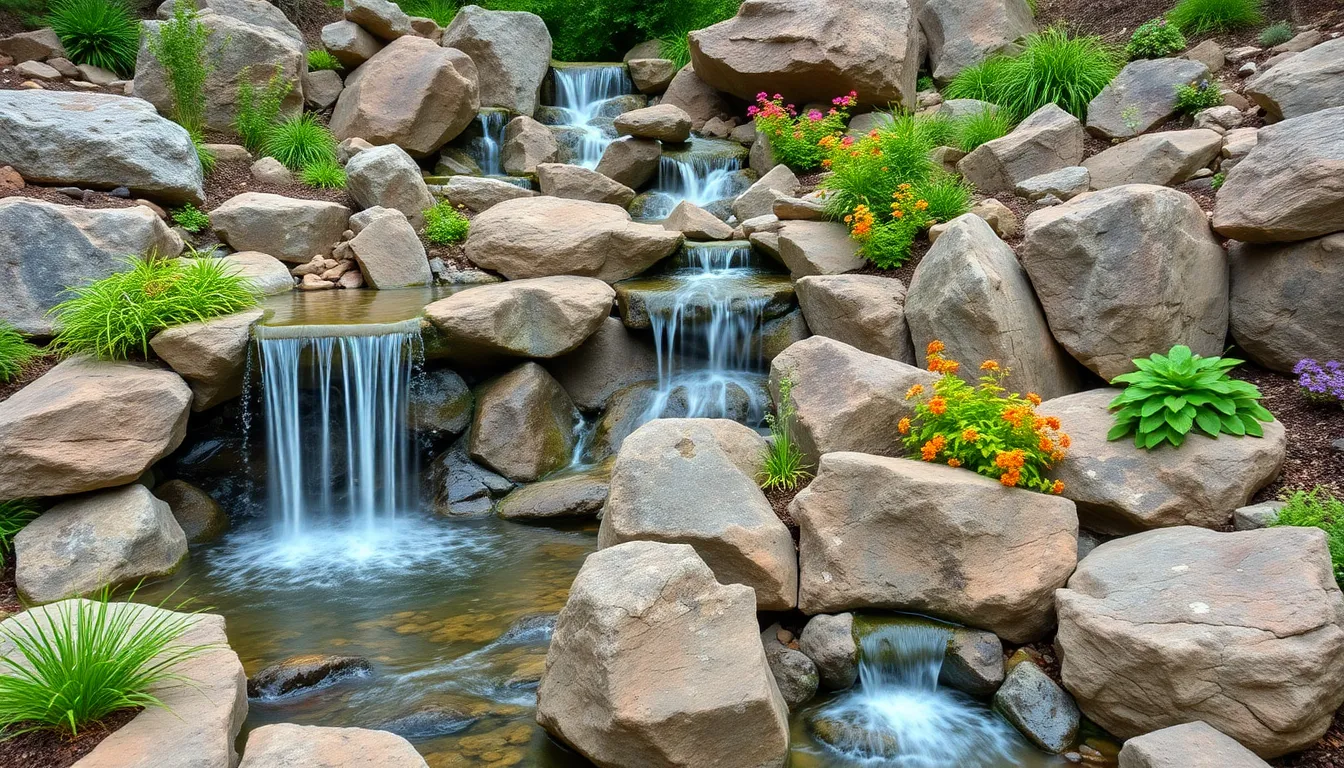
Water features transform our rock gardens into ever-changing sensory experiences that combine the beauty of stone with the tranquil sounds of flowing water. These additions create focal points while supporting the natural network we’re building.
Install a Small Waterfall or Stream
Installing a waterfall creates the most dramatic water feature for our rock garden design. We position the water source at the highest elevation point and allow it to cascade naturally over carefully arranged rocks and boulders. Natural stone formations guide the water flow down through multiple tiers, creating different sounds and visual effects at each level.
Streams work exceptionally well in sloped rock gardens where we can follow the natural contours of our industry. We embed flat stones along the stream bed to create gentle pools and rapids that add movement and interest. The cascading water over natural rocks provides both visual appeal and the soothing sounds that make our garden a peaceful retreat.
Construction requires a recirculating pump system that moves water from a lower collection basin back to the source. We conceal the pump and plumbing behind larger rocks to maintain the natural appearance of our waterfall or stream feature.
Create a Rock Pool or Pond
Rock pools serve as stunning centerpieces that reflect our surrounding stone formations and plantings. We excavate the pool area and line it with flexible pond liner, then edge it with various sized rocks that appear naturally placed. Large boulders anchor the corners while smaller stones create transitions between the water and our garden beds.
Ponds work particularly well when we incorporate them into lower areas of our rock garden where water would naturally collect. We plant moisture loving species like sedges and small ferns around the edges to create a cohesive network. The still water surface provides a mirror effect that doubles the visual impact of our vertical rock arrangements.
Depth varies from shallow edges at 6 inches to deeper centers around 18 to 24 inches for proper water circulation. We add aquatic plants like water lilies or lotus to provide natural filtration and prevent algae growth in our rock pool feature.
Consider a Simple Bubbling Fountain
Bubbling fountains offer the easiest water feature installation while providing maximum impact with minimal maintenance requirements. We drill holes in large boulders or flat stones to create natural looking fountains that bubble up through the rock surface. The water flows over the stone and disappears into a hidden reservoir filled with smaller rocks.
Simple fountains blend seamlessly with our existing rock arrangements since they use the same materials and natural forms. We position them near seating areas or main pathways where visitors can appreciate both the visual and auditory elements. The gentle bubbling sound creates ambiance without overwhelming conversation or quiet reflection.
Installation involves placing a small submersible pump in an underground reservoir and running tubing up through our chosen fountain rock. We surround the reservoir with decorative gravel and stones that allow water to filter back down while maintaining the natural appearance of our rock garden design.
Incorporate Decorative Elements and Accessories

Decorative elements transform a basic rock garden into a personalized outdoor sanctuary that reflects your unique style. We’ll explore how strategic placement of sculptural stones, artistic accents, and thoughtful lighting can elevate your garden’s visual appeal while maintaining its natural harmony.
Place Sculptural Stones and Boulders
Sculptural stones serve as natural artwork that creates stunning focal points throughout your garden space. We recommend positioning large boulders first to establish primary visual anchors and define distinct zones within your rock garden layout. Stacked stone formations add vertical interest and symbolize stability while creating dramatic height variations that draw the eye upward.
Strategic boulder placement helps establish the garden’s structural foundation and provides natural seating areas for quiet contemplation. We’ve found that arranging stones in odd numbers creates more visually pleasing compositions that feel organic rather than forced. Weathered stones with interesting textures and natural formations make excellent conversation pieces that showcase nature’s artistry.
Consider incorporating abstract stone sculptures to transform your garden into an outdoor art gallery that evolves with changing light throughout the day. Large sculptural boulders can define pathways and create natural gathering spaces where visitors pause to appreciate your garden’s unique character.
Add Garden Art and Metal Accents
Garden art introduces personality and creative expression while complementing the natural stone elements in your industry design. We suggest selecting metal planters and decorative pieces that contrast beautifully with organic rock formations, creating visual tension that makes both elements more striking. Weathered copper or rusted steel accents develop patina over time, blending seamlessly with the natural aging process of stones.
Metal sculptures and artistic installations can serve as year round focal points that remain visually interesting even when plants enter dormancy. We recommend choosing pieces that echo the angular or curved lines found in your rock formations to maintain design cohesion. Garden stakes, metal orbs, and sculptural plant supports add functional beauty while improving the three dimensional quality of your space.
Artistic elements should complement rather than compete with your stone arrangements, creating harmony between manufactured and natural materials. We’ve observed that strategically placed art pieces can guide visitors’ attention to exact garden areas and create memorable stopping points along pathways.
Include Lighting for Evening Ambiance
Evening lighting extends your garden’s usability while creating magical atmospheric effects that transform the space after sunset. We recommend installing solar lights among rock formations to produce warm, welcoming illumination that highlights texture and shadows without overwhelming the natural setting. Pathway lighting along stepping stone routes enhances both safety and visual appeal during nighttime garden exploration.
LED strip lights tucked behind larger boulders create dramatic uplighting effects that emphasize the sculptural qualities of your stone arrangements. We’ve found that low voltage industry lighting systems offer reliable performance while consuming minimal energy throughout the growing season. Timer controlled lighting allows you to customize illumination schedules that match your outdoor entertainment needs.
Subtle accent lighting can highlight water features, sculptural elements, and specimen plants while maintaining the garden’s peaceful nighttime ambiance. We suggest avoiding harsh spotlights that create unwanted glare, instead opting for soft, diffused illumination that preserves the natural mystery of your rock garden after dark.
Create Themed Rock Garden Styles
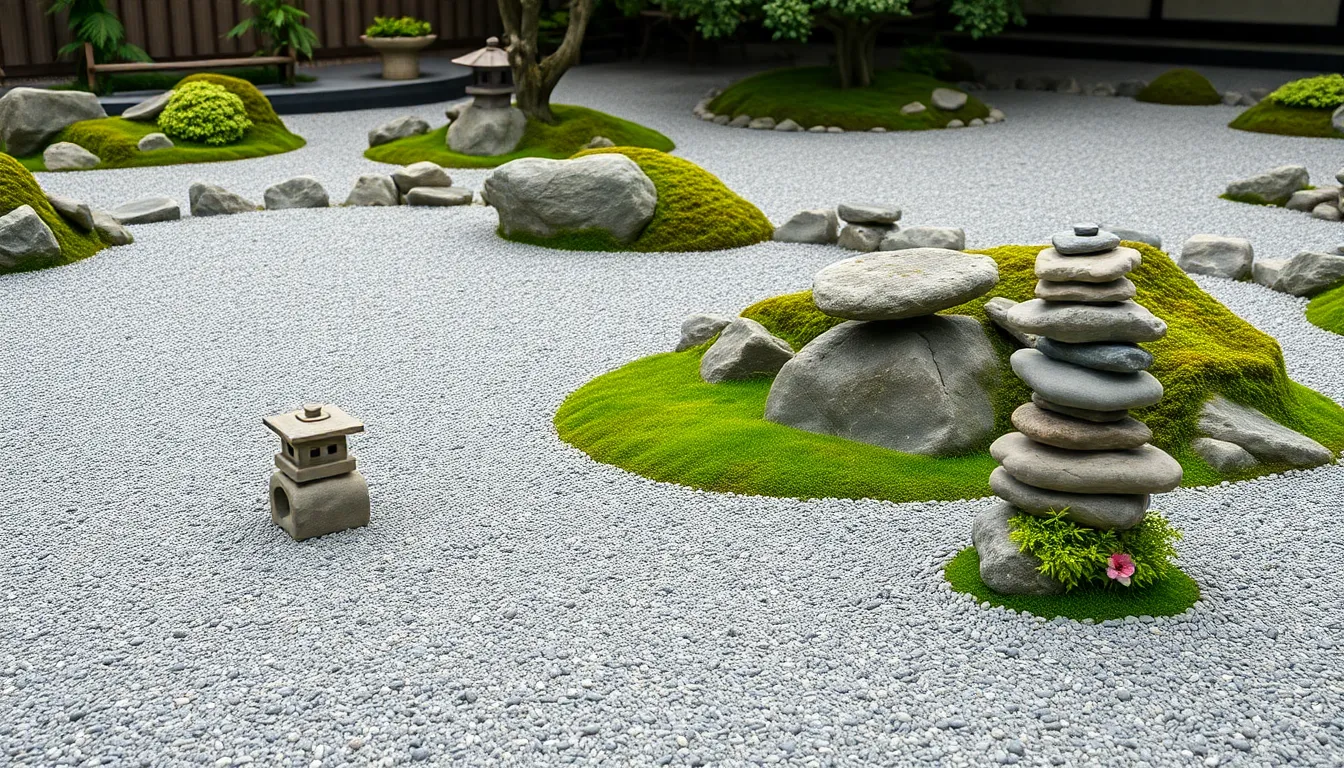
Themed rock gardens let us transform outdoor spaces into distinctive landscapes that reflect exact cultural aesthetics or regional characteristics. We can choose from various design approaches that complement our home’s architecture and personal preferences.
Design a Japanese Zen Garden
Japanese Zen gardens emphasize tranquility and symbolic meaning through carefully arranged elements. We should use stacked stones to represent stability and creativity while incorporating raked gravel or sand patterns that symbolize flowing water.
Essential design elements include:
- Larger stones positioned as focal points to anchor the composition
- Smooth gravel raked in flowing patterns around stone groupings
- Minimal plant selections featuring low maintenance varieties like mosses
- Asymmetrical arrangements that create visual balance without perfect symmetry
Plant selection focuses on simplicity:
- Bonsai trees provide sculptural interest without overwhelming the space
- Japanese maples add seasonal color transitions
- Moss groundcover softens stone edges naturally
- Ornamental grasses create gentle movement in breezes
Special features enhance the meditative atmosphere:
- Stone lanterns serve as both lighting and decorative elements
- Small water features like bamboo fountains add soothing sounds
- Wooden benches positioned for contemplation and viewing
- Stepping stones create pathways for mindful walking
Build a Mediterranean Coastal Garden
Mediterranean coastal gardens capture the rugged beauty of seaside landscapes through strategic use of boulders and drought resistant plants. We can incorporate large stones that mimic rocky coastlines while selecting plants that thrive in dry conditions.
Design elements reflect coastal environments:
- Massive boulders positioned as dramatic centerpieces
- Smaller stones scattered to create natural transitions
- Terraced levels that suggest clifftop formations
- Light colored stones that reflect Mediterranean sunshine
Plant choices emphasize drought tolerance:
- Succulents like Agave and Aloe provide architectural forms
- Lavender bushes offer fragrance and purple flower spikes
- Rosemary shrubs contribute evergreen structure and culinary value
- Thyme groundcover fills spaces between stones with aromatic foliage
Decorative features complete the theme:
- Terracotta pots in various sizes add authentic Mediterranean character
- Small fountains provide cooling water sounds
- Olive trees in containers create shade and cultural authenticity
- Weathered driftwood pieces enhance the coastal aesthetic
Develop a Native Plant Rock Garden
Native plant rock gardens celebrate local ecosystems while requiring minimal maintenance and water resources. We should select indigenous rocks and stones that blend seamlessly with our regional industry characteristics.
Rock selection emphasizes local materials:
- Native boulders and stones match surrounding geological features
- Local quarry materials provide authentic color palettes
- Fieldstone creates natural looking boundaries and pathways
- Stepping stones offer access without disrupting plant growth
Native plant combinations ensure sustainability:
- Indigenous perennials require no supplemental watering once established
- Native shrubs provide year round structure and wildlife habitat
- Regional grasses add texture and seasonal interest
- Wildflowers attract beneficial insects and pollinators
- Small ponds or birdbaths provide water sources for animals
- Native berry producing plants feed local bird populations
- Rock crevices offer shelter for beneficial insects
- Log or brush piles create habitat for small creatures
Plan for Seasonal Interest and Color
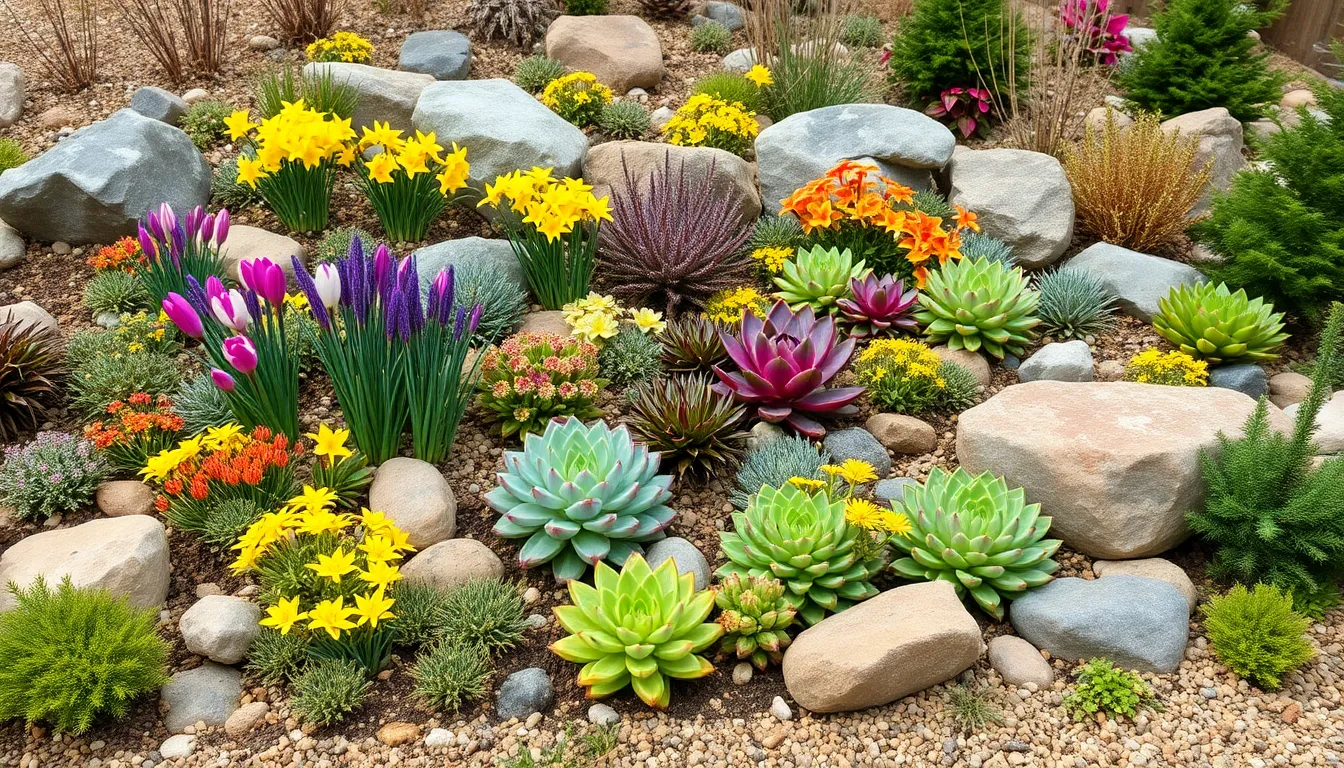
Creating a rock garden that captivates throughout the year requires strategic plant selection that provides continuous visual appeal. We’ll guide you through choosing plants that ensure your garden remains vibrant across all four seasons.
Select Plants for Spring Blooms
Spring flowering bulbs transform your rock garden into an early season showcase after winter’s dormancy. Crocus, daffodils, and tulips provide the first bursts of color when planted in natural clusters between larger stones. These early bloomers establish the foundation for year-round interest while requiring minimal maintenance once established.
Aubrieta creates stunning purple cascades over rocky ledges and walls during spring months. Low growing alpine plants like arabis offer delicate white flowers that complement the natural stone textures. Phlox subulata spreads across rocky surfaces with vibrant pink, white, or purple blooms that thrive in well-drained conditions.
Planting these spring varieties in groups of three to five creates natural looking displays that mirror wild alpine environments. Position bulbs near larger boulders where they’ll receive protection from harsh winds while maintaining excellent drainage.
Choose Summer Flowering Varieties
Drought tolerant succulents become the stars of summer rock gardens with their unique textures and subtle flowering displays. Sedum varieties offer fleshy foliage that changes color throughout the season while producing star shaped flowers in late summer. Sempervivum creates architectural rosettes that multiply naturally and require virtually no water once established.
Ornamental grasses add movement and height to summer displays while providing seed heads for extended interest. Coreopsis delivers bright yellow daisy like flowers from early summer through fall with deadheading. Yarrow produces flat topped flower clusters in colors ranging from white to deep red while attracting beneficial pollinators.
Native wildflowers create natural looking displays that support local ecosystems with minimal maintenance requirements. Group these summer bloomers according to their water and sun requirements to ensure optimal growth and flowering performance.
Include Fall Foliage and Winter Structure
Dwarf conifers provide essential structure while delivering spectacular fall color transformations in your rock garden. Heather offers late season purple or pink blooms that extend flowering well into autumn. Cotoneaster produces bright red berries that attract birds while providing brilliant orange and red foliage displays.
Evergreen selections like juniper and dwarf spruce maintain green color and structural interest throughout winter months. These plants serve as backbone elements that define garden spaces when deciduous plants enter dormancy. Their varied textures and forms create visual anchors that support the overall design.
Decorative stones and carefully positioned boulders become prominent focal points during winter when plant material is less dominant. Garden art and sculptural elements gain increased visibility and importance as seasonal structure providers. Strategic placement of these permanent features ensures your rock garden maintains visual appeal even during the dormant season.
Maintain Your Rock Garden Throughout the Year

Our rock garden’s long-term success depends on consistent seasonal care that protects both plants and structural elements. We’ll guide you through essential maintenance practices that keep your garden thriving year-round.
Establish Proper Watering Techniques
Water deeply during hot spells to prevent soil from drying out too quickly. Rocks absorb heat throughout the day and can significantly raise soil temperatures, causing plants to lose moisture faster than in traditional gardens.
Check soil moisture regularly by inserting your finger 2-3 inches into the ground around plant bases. We recommend watering early morning or late evening to minimize evaporation and give plants time to absorb water before peak heat hours.
Install drip irrigation systems for consistent moisture delivery without disturbing rock arrangements. These systems provide precise water amounts directly to plant roots while avoiding water waste on stone surfaces.
Adjust watering frequency seasonally by increasing during summer months and reducing in fall and winter. Most rock garden plants prefer less frequent but thorough watering rather than daily light sprinkles.
Control Weeds and Unwanted Growth
Use smaller rocks or gravel as natural weed suppressants between larger stones and around plant bases. This mulching method prevents weed seeds from germinating while maintaining the garden’s aesthetic appeal.
Remove weeds manually to avoid damaging plant roots and disturbing carefully placed rocks. We recommend using a long-handled weeder or hand tools specifically designed for tight spaces between stones.
Apply industry fabric beneath rock layers during initial installation to create a barrier against persistent weeds. Cut small holes in the fabric where you plan to place plants, allowing for proper growth while blocking unwanted vegetation.
Monitor for invasive species monthly and remove them immediately before they establish root systems. Common invaders include dandelions, crabgrass, and volunteer tree seedlings that can disrupt your garden’s design.
Perform Annual Plant Care and Pruning
Fertilize plants based on their exact needs rather than applying general-purpose fertilizers. Alpines and succulents require little to no fertilizer, while flowering perennials may benefit from light feeding in early spring.
Prune annually to maintain plant shape and promote healthy new growth. We recommend pruning most rock garden plants in late winter or early spring before new growth begins.
Divide overcrowded perennials every 3-4 years to prevent them from overwhelming smaller neighboring plants. This practice also provides new plants for expanding your rock garden or sharing with fellow gardeners.
Replace damaged or dead plants promptly to maintain visual continuity and prevent open spaces from becoming weed magnets. Keep a list of your plant varieties to ensure replacements match your original design vision.
Conclusion
Rock gardens offer an incredible opportunity to transform any outdoor space into a stunning low-maintenance industry that improves with age. We’ve explored everything from selecting the perfect location and choosing the right stones to incorporating drought-tolerant plants and adding captivating water features.
The beauty of rock gardening lies in its flexibility – whether you’re working with a small corner or an expansive slope you can create something truly spectacular. By following the design principles we’ve covered and selecting plants that thrive in your climate you’ll establish a garden that requires minimal upkeep while delivering maximum visual impact.
Remember that successful rock gardens develop their character over time. Start with a solid foundation of well-placed stones choose plants that complement your vision and don’t be afraid to add personal touches that reflect your style. Your rock garden will reward you with years of natural beauty and peaceful enjoyment.
Frequently Asked Questions
What is a rock garden and why are they popular?
A rock garden is a landscaped area that combines natural stone formations with carefully selected plants, typically featuring drought-tolerant varieties like alpine plants and succulents. They’re popular because they offer significant visual impact with minimal maintenance requirements, making them ideal for busy homeowners who want beautiful outdoor spaces without constant upkeep.
What’s the best location for a rock garden?
Choose a location that receives 6-8 hours of direct sunlight daily with excellent drainage. Gentle slopes work best for construction, and utilizing existing natural features enhances the design. Consider accessibility for maintenance and proximity to water sources. Avoid areas prone to standing water or heavy shade.
What types of rocks should I use in my rock garden?
Use local stones for authenticity and visual harmony, as they’re more affordable and suited to your climate. Mix different textures and colors within a natural earth-tone palette for visual depth. Place larger boulders first to define focal areas, then fill transitional spaces with smaller rocks for balanced composition.
Which plants work best in rock gardens?
Drought-tolerant plants like Sedum, Yucca, and Agave thrive in rocky conditions with minimal water and maintenance. Include alpine plants, succulents, and evergreens like junipers or dwarf conifers for year-round structure. Choose plants with different bloom times to ensure continuous color throughout the seasons.
Can I add water features to my rock garden?
Yes, water features enhance rock gardens by creating sensory experiences with flowing water sounds. Consider small waterfalls, streams that follow natural contours, rock pools with moisture-loving plants, or simple bubbling fountains. These features add visual impact and tranquility while blending seamlessly with the natural stone elements.
How do I maintain my rock garden?
Use deep watering techniques during hot spells and consider drip irrigation for consistent moisture. Control weeds through manual removal and natural methods, applying landscape fabric during installation. Perform annual plant care including fertilization, pruning, and replacing damaged plants to maintain visual continuity and garden health.
What are some popular rock garden styles?
Popular styles include Japanese Zen gardens with stacked stones and raked gravel, Mediterranean coastal gardens featuring drought-resistant plants and large boulders, and native plant rock gardens celebrating local ecosystems. Each style incorporates specific design elements, plant choices, and decorative features reflecting cultural or regional characteristics.
How can I ensure year-round interest in my rock garden?
Plan for seasonal variety by selecting spring bloomers like crocus and daffodils, summer succulents and ornamental grasses, fall foliage plants, and winter structure through dwarf conifers and evergreens. This strategic plant selection ensures your rock garden remains visually appealing throughout all seasons.

